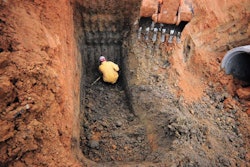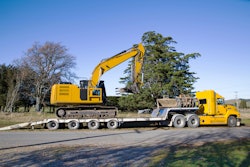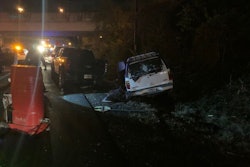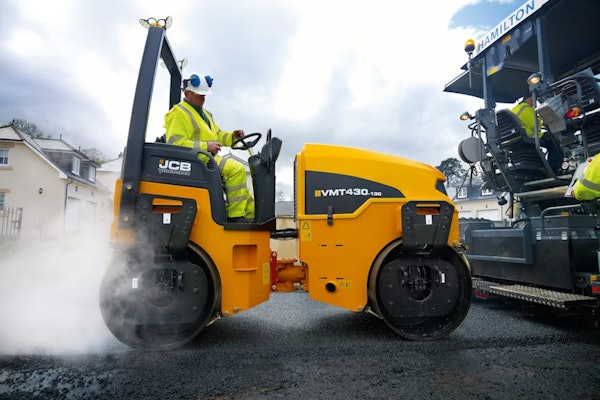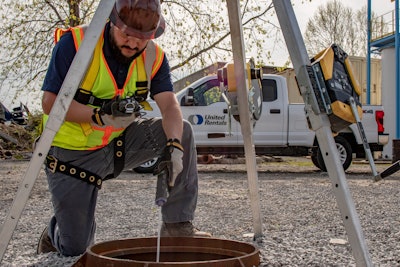
A truck is parked beside a manhole that a worker has just entered. It’s a cold day so the truck is running, but no one’s thinking about the hazardous fumes heading down the hole. Unfortunately, it’s one of countless daily evidences that OSHA’s confined spaces standards for the construction industry are widely misunderstood and frequently not applied.
OSHA’s 2015 revisions to the 1994 Confined Space Standard 1920.146 were the subject of a workshop presented at United Rentals’ Total Control and Innovation Conference this week in San Antonio, Texas, underscoring the rental giant’s top messaging: UR is serious about putting customer advocacy into action.
Trenching safety experts Bruce Magee and Chad Lindsley, UR region product development managers, took attendees into the proverbial trenches of the 2015 Confined Spaces rule 1926AA.
The OSHA rollout four-plus years ago, said Magee, was about as smooth as tangled fishing line, namely because the original standard remained, leaving industrial businesses to figure out which standard to follow. Industrial and construction firms, he says, have erroneously continued to follow the original standard, which was intended to protect employees in general industry, not agriculture, construction or shipyard employment. While there are similarities between the old and revised standards, important differences have to be understood and applied for confined spaces safety compliance today.
Central to compliance: If you’re in construction, the new rules apply.
Magee was quick to note that choosing which rules to follow is not an option, citing a statement from OSHA: “…An employer does not have the option of bypassing the procedures that are unique to this final rule by complying instead with [the original] § 1910.146. Such a policy would severely undermine OSHA’s effort to protect employees from the unique hazards present during confined-space operations in construction.”
What you need to know right now
Following are a few highlights of the revised OSHA standard as outlined by Magee and Lindsley:
(1) The new definition of confined space boils down to three components, and all three conditions must exist: limited means of entry/exit, large enough to enter, and not designed for continuous occupancy. Examples of OSHA-defined confined spaces include manholes, tunnels, wells, tanks, pipes, grease pits, cold storage, subcellars, culverts and silos.
(2) Always test and continue to test throughout a project that involves Permit-Required Confined Spaces (PRCSs) in case hazardous conditions occur while the work is being performed.
(3) A “Qualified Person” is no longer adequate as the responsible individual during entry of confined space; 1926AA calls for a Competent Person, and, says Lindsley, it’s a mistake to blanket categorize everyone on the team with this designation.
Here’s how Lindsley and Magee explained the difference:
Competent Person: “One capable of identifying existing and predictable hazards in the surroundings or working conditions that are unsanitary, hazardous, or dangerous to employees, and who has authority to take prompt corrective measures to eliminate them.”
Qualified Person: “One who, by possession of a recognized degree, certificate, or professional standing, or who by extensive knowledge, training, and experience, has successfully demonstrated their ability to solve or resolve problems relating to the subject matter, the work, or the project.”
(4) Four individuals are required to perform specific roles at a PRCS:
- Authorized Entrant – An employee is authorized by the entry supervisor to enter a PRCS and must know the confined space hazards, physical symptoms and consequences, as well as understand the proper use of all equipment to be used in the PRCS. There will be constant communication with the attendant, and the entrant will exit promptly when necessary or advised by the attendant.
- Attendant – This individual is stationed outside one or more PRSCs to ensure that employees can safely enter and work within the space. The attendant remains outside the PRCS, monitoring both the entrant and surrounding area (remember the truck fumes where we started?), and ready to summon rescue if needed.
- Entry Supervisor – The qualified person (employer, foreman, crew chief) who is responsible for determining if acceptable entry conditions are present at a PRCS.
- Emergency Rescue Personnel – Employers must select a rescue team or emergency service that has the capability to reach the victim(s) in a timely manner, is equipped for and proficient in performing rescue services, and agrees to notify the employer immediately if the rescue service becomes unavailable.
(5) Training is big. OSHA’s 1926AA requires that employers provide training to all affected employees in a language and vocabulary that the worker understands. Further, Magee explained, the training must be:
- At no cost to employee
- Before the first PRCS entry assignment
- Before duties change
- Whenever hazards change
For more information, click here.




